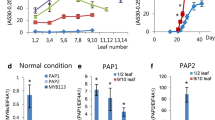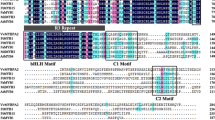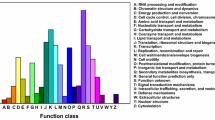Abstract
Tea plant (Camellia sinensis) has very long history of cultivation and abundant germplasm resources in China. Purple bud is a characteristic variety, which has attracted the attention of breeding researchers because it accumulated a large number of anthocyanins naturally. In many species, R2R3-MYB transcription factors (TFs) were proved to be involved in the regulation of anthocyanin biosynthesis. Research on anthocyanin metabolism has been relatively clear in some species, but that needs to be further elucidated in tea plants. In this research, an R2R3-MYB transcription factor CsMYB113 related to the anthocyanin accumulation regulation was identified from tea plants. Spatial and temporal expression analysis revealed differential expression of CsMYB113 among different tissues and organs, with highest expression occurring in the roots. Subcellular localization assays showed that CsMYB113 localized in the nucleus. Ectopic expression of CsMYB113 increased pigmentation and anthocyanin contents by the upregulation of the expression levels of genes in anthocyanin biosynthesis pathway among different tissues of Arabidopsis. Moreover, transient overexpression of 35S::CsMYB113 in tea plant increased the anthocyanin contents in the leaves. Our results indicated that CsMYB113 plays important role in the anthocyanin biosynthesis regulation in tea plants. It will also provide useful candidate gene for the modification of anthocyanin metabolism by genetic engineering in plants.







Similar content being viewed by others
References
Ban Y, Honda C, Hatsuyama Y, Igarashi M, Bessho H, Moriguchi T (2007) Isolation and functional analysis of a MYB transcription factor gene that is a key regulator for the development of red coloration in apple skin. Plant Cell Physiol 48(7):958–970
Baudry A, Heim MA, Dubreucq B, Caboche M, Weisshaar B, Lepiniec L (2004) TT2, TT8, and TTG1 synergistically specify the expression of BANYULS and proanthocyanidin biosynthesis in Arabidopsis thaliana. Plant J 39(3):366–380
Cao YL, Xie LF, Ma YY, Ren CH, Xing MY, Fu ZS, Wu XY, Yin XR, Xu CJ, Li X (2019) PpMYB15 and PpMYBF1 transcription factors are involved in regulating flavonol biosynthesis in peach fruit. J Agr Food Chem 67(2):644–652
Castellarin SD, Pfeiffer A, Sivilotti P, Degan M, Peterlunger E, Di Gaspero G (2007) Transcriptional regulation of anthocyanin biosynthesis in ripening fruits of grapevine under seasonal water deficit. Plant Cell Environ 30(11):1381–1399
Chen X, Wang P, Gu M, Lin X, Hou B, Zheng Y, Sun Y, Jin S, Ye N (2021) R2R3-MYB transcription factor family in tea plant (Camellia sinensis): genome-wide characterization, phylogeny, chromosome location, structure and expression patterns. Genomics 113(3):1565–1578
Chen XR, Wang Y, Zhao HH, Zhang XY, Wang XB, Li DW, Yu JL, Han CG (2018) Brassica yellows virus' movement protein upregulates anthocyanin accumulation, leading to the development of purple leaf symptoms on Arabidopsis thaliana. Sci Rep-Uk 8
Chiu LW, Zhou XJ, Burke S, Wu XL, Prior RL, Li L (2010) The purple cauliflower arises from activation of a MYB transcription factor. Plant Physiol 154(3):1470–1480
Christie PJ, Alfenito MR, Walbot V (1994) Impact of low-temperature stress on general phenylpropanoid and anthocyanin pathways - enhancement of transcript abundance and anthocyanin pigmentation in maize seedlings. Planta 194(4):541–549
Chu H, Jeong JC, Kim WJ, Chung DM, Jeon HK, Ahn YO, Kim SH, Lee HS, Kwak SS, Kim CY (2013) Expression of the sweetpotato R2R3-type IbMYB1a gene induces anthocyanin accumulation in Arabidopsis. Physiol Plantarum 148(2):189–199
Clifford T, Howatson G, West DJ, Stevenson EJ (2015) The potential benefits of red beetroot supplementation in health and disease. Nutrients 7(4):2801–2822
Clough SJ, Bent AF (1998) Floral dip: a simplified method for Agrobacterium-mediated transformation of Arabidopsis thaliana. Plant J 16(6):735–743
Cone KC, Burr FA, Burr B (1986) Molecular analysis of the maize anthocyanin regulatory locus C1. P Natl Acad Sci USA 83(24):9631–9635
Deng J, Li JJ, Su MY, Lin ZY, Chen L, Yang PF (2021) A bHLH gene NnTT8 of Nelumbo nucifera regulates anthocyanin biosynthesis. Plant Physiol Bioch 158:518–523. https://doi.org/10.1016/j.plaphy.2020.11.038
Docimo T, Francese G, Ruggiero A, Batelli G, De Palma M, Bassolino L, Toppino L, Rotino GL, Mennella G, Tucci M (2016) Phenylpropanoids Accumulation in eggplant fruit: characterization of biosynthetic genes and regulation by a MYB transcription factor. Front Plant Sci 6
Dubos C, Stracke R, Grotewold E, Weisshaar B, Martin C, Lepiniec L (2010) MYB transcription factors in Arabidopsis. Trends Plant Sci 15(10):573–581
Elomaa P, Uimari A, Mehto M, Albert VA, Laitinen RAE, Teeri TH (2003) Activation of anthocyanin biosynthesis in Gerbera hybrida (Asteraceae) suggests conserved protein-protein and protein-promoter interactions between the anciently diverged monocots and eudicots. Plant Physiol 133(4):1831–1842
Espley RV, Hellens RP, Putterill J, Stevenson DE, Kutty-Amma S, Allan AC (2007) Red colouration in apple fruit is due to the activity of the MYB transcription factor, MdMYB10. Plant J 49(3):414–427
Fang W, Cheng H, Duan Y, Jiang X, Li X (2012) Genetic diversity and relationship of clonal tea (Camellia sinensis) cultivars in China as revealed by SSR markers. Plant Syst Evol 298(2):469–483
Feng SQ, Wang YL, Yang S, Xu YT, Chen XS (2010) Anthocyanin biosynthesis in pears is regulated by a R2R3-MYB transcription factor PyMYB10. Planta 232(1):245–255
Gong ND, Guo LL, Wang HX, Zhao L, Wang J, Wang WZ, Liu YJ, Wang YS, Gao LP, Xia T (2014) Cloning and functional verification of two MYB transcription factors in tea plant [Camellia sinensis (L.) ]. J Tea Sci 34(1):36–44
Gonzalez A, Zhao M, Leavitt JM, Lloyd AM (2008) Regulation of the anthocyanin biosynthetic pathway by the TTG1/bHLH/Myb transcriptional complex in Arabidopsis seedlings. Plant J 53(5):814–827
Guo F, Guo YF, Wang P, Wang Y, Ni DJ (2017) Transcriptional profiling of catechins biosynthesis genes during tea plant leaf development. Planta 246(6):1139–1152
He JA, Giusti MM (2010) Anthocyanins: natural colorants with health-promoting properties. Annu Rev Food Sci T 1:163–187
He Q, Lu QQ, He YT, Wang YX, Zhang NN, Zhao WB, Zhang LG (2020) Dynamic changes of the anthocyanin biosynthesis mechanism during the development of heading Chinese cabbage (Brassica rapa L.) and Arabidopsis under the control of BrMYB2. Front Plant Sci 11
He XJ, Zhao XC, Gao LP, Shi XX, Dai XL, Liu YJ, Xia T, Wang YS (2018) Isolation and characterization of key genes that promote flavonoid accumulation in purple-leaf tea (Camellia sinensis L.). Sci Rep-Uk 8
Hoffmann T, Kalinowski G, Schwab W (2006) RNAi-induced silencing of gene expression in strawberry fruit (Fragaria x ananassa) by agroinfiltration: a rapid assay for gene function analysis. Plant J 48(5):818–826
Hsu CP, Shih YT, Lin BR, Chiu CF, Lin CC (2012) Inhibitory effect and mechanisms of an anthocyanins- and anthocyanidins-rich extract from purple-shoot tea on colorectal carcinoma cell proliferation. J Agr Food Chem 60(14):3686–3692
Huang WJ, Sun W, Lv HY, Luo M, Zeng SH, Pattanaik S, Yuan L, Wang Y (2013a) A R2R3-MYB transcription factor from Epimedium sagittatum regulates the flavonoid biosynthetic pathway. Plos One 8(8)
Huang YJ, Song S, Allan AC, Liu XF, Yin XR, Xu CJ, Chen KS (2013b) Differential activation of anthocyanin biosynthesis in Arabidopsis and tobacco over-expressing an R2R3 MYB from Chinese bayberry. Plant Cell Tiss Org 113(3):491–499
Jaakola L (2013) New insights into the regulation of anthocyanin biosynthesis in fruits. Trends Plant Sci 18(9):477–483
Jia HG, Wang N (2014) Targeted Genome Editing of Sweet Orange Using Cas9/sgRNA. Plos One 9(4)
Jiang LH, Shen XJ, Shoji T, Kanda T, Zhou JC, Zhao LM (2013) Characterization and activity of anthocyanins in Zijuan tea (Camellia sinensis var. kitamura). J Agr Food Chem 61(13):3306–3310
Jiang XL, Huang KY, Zheng GS, Hou H, Wang PQ, Jiang H, Zhao XC, Li MZ, Zhang SX, Liu YJ, Gao LP, Zhao L, Xia T (2018) CsMYB5a and CsMYB5e from Camellia sinensis differentially regulate anthocyanin and proanthocyanidin biosynthesis. Plant Sci 270:209–220
Karageorgou P, Manetas Y (2006) The importance of being red when young: anthocyanins and the protection of young leaves of Quercus coccifera from insect herbivory and excess light. Tree Physiol 26(5):613–621
Kerio LC, Wachira FN, Wanyoko JK, Rotich MK (2012) Characterization of anthocyanins in Kenyan teas: Extraction and identification. Food Chem 131(1):31–38. https://doi.org/10.1016/j.foodchem.2011.08.005
Kilel EC, Faraj AK, Wanyoko JK, Wachira FN, Mwingirwa V (2013) Green tea from purple leaf coloured tea clones in Kenya- their quality characteristics. Food Chem 141(2):769–775
Li CH, Qiu F, Ding L, Huang MZ, Huang SR, Yang GS, Yin JM (2017a) Anthocyanin biosynthesis regulation of DhMYB2 and DhbHLH1 in Dendrobium hybrids petals. Plant Physiol Bioch 112:335–345
Li MZ, Li YZ, Guo LL, Gong ND, Pang YZ, Jiang WB, Liu YJ, Jiang XL, Zhao L, Wang YS, Xie DY, Gao LP, Xia T (2017b) Functional characterization of tea (Camellia sinensis) MYB4a transcription factor using an integrative approach. Front Plant Sci 8
Li YQ, Shan XT, Tong LN, Wei C, Lu KY, Li SY, Kimani S, Wang SC, Wang L, Gao X (2020) The conserved and particular roles of the R2R3-MYB regulator FhPAP1 from Freesia hybrida in flower anthocyanin biosynthesis. Plant Cell Physiol 61(7):1365–1380
Liu JY, Osbourn A, Ma PD (2015) MYB transcription factors as regulators of phenylpropanoid metabolism in plants. Mol Plant 8(5):689–708
Liu Y, Tikunov Y, Schouten RE, Marcelis LFM, Visser RGF, Bovy A (2018a) Anthocyanin biosynthesis and degradation mechanisms in solanaceous vegetables: a review. Front Chem 6:52
Liu YJ, Hou H, Jiang XL, Wang PQ, Dai XL, Chen W, Gao LP, Xia T (2018b) A WD40 Repeat Protein from Camellia sinensis Regulates Anthocyanin and Proanthocyanidin Accumulation through the Formation of MYB-bHLH-WD40 Ternary Complexes. Int J Mol Sci 19(6)
Livak KJ, Schmittgen TD (2001) Analysis of relative gene expression data using real-time quantitative PCR and the 2(T)(-Delta Delta C) method. Methods 25(4):402–408
Maritim TK, Masand M, Seth R, Sharma RK (2021) Transcriptional analysis reveals key insights into seasonal induced anthocyanin degradation and leaf color transition in purple tea (Camellia sinensis (L.) O. Kuntze). Sci Rep-Uk 11(1)
Matsui K, Umemura Y, Ohme-Takagi M (2008) AtMYBL2, a protein with a single MYB domain, acts as a negative regulator of anthocyanin biosynthesis in Arabidopsis. Plant J 55(6):954–967
Mo RL, Huang YM, Yang SC, Zhang QL, Luo ZR (2015) Development of Agrobacterium-mediated transient transformation in persimmon (Diospyros kaki Thunb.). Sci Hortic-Amsterdam 192:29–37
Mondal TK, Bhattacharya A, Laxmikumaran M, Ahuja PS (2004) Recent advances of tea (Camellia sinensis) biotechnology. Plant Cell Tiss Org 76(3):195–254
Ni JB, Premathilake AT, Gao YH, Yu WJ, Tao RY, Teng YW, Bai SL (2021) Ethylene-activated PpERF105 induces the expression of the repressor-type R2R3-MYB gene PpMYB140 to inhibit anthocyanin biosynthesis in red pear fruit. Plant J 105(1):167–181
Peng YY, Kui LW, Cooney JM, Wang T, Espley RV, Allan AC (2019) Differential regulation of the anthocyanin profile in purple kiwifruit (Actinidia species). Hortic Res-England 6
Perez-Diaz JR, Perez-Diaz J, Madrid-Espinoza J, Gonzalez-Villanueva E, Moreno Y, Ruiz-Lara S (2016) New member of the R2R3-MYB transcription factors family in grapevine suppresses the anthocyanin accumulation in the flowers of transgenic tobacco. Plant Mol Biol 90(1–2):63–76
Qi Y, Zhou L, Han LL, Zou HZ, Miao K, Wang Y (2020) PsbHLH1, a novel transcription factor involved in regulating anthocyanin biosynthesis in tree peony (Paeonia suffruticosa). Plant Physiol Bioch 154:396–408
Quattrocchio F, Verweij W, Kroon A, Spelt C, Mol J, Koes R (2006) PH4 of petunia is an R2R3 MYB protein that activates vacuolar acidification through interactions with basic-helix-loop-helix transcription factors of the anthocyanin pathway. Plant Cell 18(5):1274–1291
Shi CY, Yang H, Wei CL, Yu O, Zhang ZZ, Jiang CJ, Sun J, Li YY, Chen Q, Xia T, Wan XC (2011) Deep sequencing of the Camellia sinensis transcriptome revealed candidate genes for major metabolic pathways of tea-specific compounds. Bmc Genomics 12
Sparkes IA, Runions J, Kearns A, Hawes C (2006) Rapid, transient expression of fluorescent fusion proteins in tobacco plants and generation of stably transformed plants. Nat Protoc 1(4):2019–2025
Stuurman J, Hoballah ME, Broger L, Moore J, Basten C, Kuhlemeier C (2004) Dissection of floral pollination syndromes in petunia. Genetics 168(3):1585–1599
Sun BM, Zhu ZS, Cao PR, Chen H, Chen CM, Zhou X, Mao YH, Lei JJ, Jiang YP, Meng W, Wang YX, Liu SQ (2016) Purple foliage coloration in tea (Camellia sinensis L.) arises from activation of the R2R3-MYB transcription factor CsAN1. Sci Rep-Uk 6
Takos AM, Jaffe FW, Jacob SR, Bogs J, Robinson SP, Walker AR (2006) Light-induced expression of a MYB gene regulates anthocyanin biosynthesis in red apples. Plant Physiol 142(3):1216–1232
Urso S, Zottini M, Ruberti C, Lo Schiavo F, Stanca AM, Cattivelli L, Vale G (2013) An Agrobacterium tumefaciens-mediated gene silencing system for functional analysis in grapevine. Plant Cell Tiss Org 114(1):49–60
Vimolmangkang S, Han YP, Wei GC, Korban SS (2013) An apple MYB transcription factor, MdMYB3, is involved in regulation of anthocyanin biosynthesis and flower development. Bmc Plant Biol 13
Wang WD, Wang YH, Du YL, Zhao Z, Zhu XJ, Jiang X, Shu ZF, Yin Y, Li XH (2014) Overexpression of Camellia sinensis H1 histone gene confers abiotic stress tolerance in transgenic tobacco. Plant Cell Rep 33(11):1829–1841
Wang Y, Chang P, Pan J, Zhu J, Cui C, Ye X, Ma Y, Zhu X, Fang W, Jiang C (2019) Effect of aluminum and fluoride on R2R3-MYB transcription factor characterization and expression in Camellia sinensis. Biol Plantarum 63:298–307
Wei CL, Yang H, Wang SB, Zhao J, Liu C, Gao LP, Xia EH, Lu Y, Tai YL, She GB, Sun J, Cao HS, Tong W, Gao Q, Li YY, Deng WW, Jiang XL, Wang WZ, Chen Q, Zhang SH, Li HJ, Wu JL, Wang P, Li PH, Shi CY, Zheng FY, Jian JB, Huang B, Shan D, Shi MM, Fang CB, Yue Y, Li FD, Li DX, Wei S, Han B, Jiang CJ, Yin Y, Xia T, Zhang ZZ, Bennetzen JL, Zhao SC, Wan XC (2018) Draft genome sequence of Camellia sinensis var. sinensis provides insights into the evolution of the tea genome and tea quality. P Natl Acad Sci USA 115(18):E4151-E4158
Wei K, Wang LY, Zhang YZ, Ruan L, Li HL, Wu LY, Xu LY, Zhang CC, Zhou XG, Cheng H, Edwards R (2019) A coupled role for CsMYB75 and CsGSTF1 in anthocyanin hyperaccumulation in purple tea. Plant J 97(5):825–840
Wei K, Zhang YZ, Wu LY, Li HL, Ruan L, Bai PX, Zhang CC, Zhang F, Xu LY, Wang LY, Cheng H (2016) Gene expression analysis of bud and leaf color in tea. Plant Physiol Bioch 107:310–318
Wen CH, Chu FH (2017) A R2R3-MYB gene LfMYB113 is responsible for autumn leaf coloration in Formosan sweet gum (Liquidambar formosana Hance). Plant Cell Physiol 58(3):508–521
Xi WP, Feng J, Liu Y, Zhang SK, Zhao GH (2019) The R2R3-MYB transcription factor PaMYB10 is involved in anthocyanin biosynthesis in apricots and determines red blushed skin. Bmc Plant Biol 19
Xu WJ, Dubos C, Lepiniec L (2015) Transcriptional control of flavonoid biosynthesis by MYB-bHLH-WDR complexes. Trends Plant Sci 20(3):176–185
Zhang JX, Zhang YC, Dou YJ, Li WJ, Wang SM, Shi WJ, Sun YP, Zhang ZH (2017) Single nucleotide mutation in FvMYB10 may lead to the yellow fruit in Fragaria vesca. Mol Breeding 37 (3).
Zhong CM, Tang Y, Pang B, Li XK, Yang YP, Deng J, Feng CY, Li LF, Ren GP, Wang YQ, Peng JZ, Sun SL, Liang S, Wang XJ (2020) The R2R3-MYB transcription factor GhMYB1a regulates flavonol and anthocyanin accumulation in Gerbera hybrida. Hortic Res-England 7(1)
Funding
This work was supported by the National Natural Science Foundation of China (32072622, 31600556) and the Fundamental Research Funds for the Central Universities, Huazhong Agricultural University (2662019PY045).
Author information
Authors and Affiliations
Contributions
LS and FG designed the experiments. LS, MY, WL, and HL performed the experiments. LS and FG wrote the manuscript. WL and FG revise the manuscript. All authors provided helpful discussions and approved its final version.
Corresponding author
Ethics declarations
Competing Interests
The authors declare no competing interests.
Additional information
Publisher's Note
Springer Nature remains neutral with regard to jurisdictional claims in published maps and institutional affiliations.
Key Message
• A R2R3-MYB transcription factor CsMYB113 clustered into S6 subgroup was identified in tea plant.
• CsMYB113 act as transcription factor and localize in the nucleus.
• Overexpression CsMYB113 in Arabidopsis enhanced pigmentation and anthocyanin accumulation in various organs.
• The anthocyanin contents were significantly increased in leaves transient transformed with CsMYB113 gene.
Supplementary Information
Below is the link to the electronic supplementary material.
Rights and permissions
Springer Nature or its licensor holds exclusive rights to this article under a publishing agreement with the author(s) or other rightsholder(s); author self-archiving of the accepted manuscript version of this article is solely governed by the terms of such publishing agreement and applicable law.
About this article
Cite this article
Shui, L., Li, W., Yan, M. et al. Characterization of the R2R3-MYB Transcription Factor CsMYB113 Regulates Anthocyanin Biosynthesis in Tea Plants (Camellia sinensis). Plant Mol Biol Rep 41, 46–58 (2023). https://doi.org/10.1007/s11105-022-01348-4
Received:
Accepted:
Published:
Issue Date:
DOI: https://doi.org/10.1007/s11105-022-01348-4




